The Team Group T-Force Cardea (240GB) SSD Review: Grace Under Write Pressure
by Billy Tallis on September 28, 2017 8:00 AM ESTAnandTech Storage Bench - The Destroyer
The Destroyer is an extremely long test replicating the access patterns of very IO-intensive desktop usage. A detailed breakdown can be found in this article. Like real-world usage, the drives do get the occasional break that allows for some background garbage collection and flushing caches, but those idle times are limited to 25ms so that it doesn't take all week to run the test. These AnandTech Storage Bench (ATSB) tests do not involve running the actual applications that generated the workloads, so the scores are relatively insensitive to changes in CPU performance and RAM from our new testbed, but the jump to a newer version of Windows and the newer storage drivers can have an impact.
We quantify performance on this test by reporting the drive's average data throughput, the average latency of the I/O operations, and the total energy used by the drive over the course of the test.
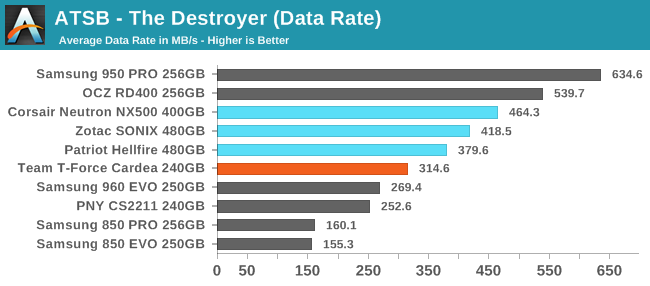
The Team T-Force Cardea has a better overall data rate on The Destroyer than the SATA drives or the Samsung 960 EVO, but the larger Phison E7 drives and the 256GB MLC-based NVMe drives are much faster.
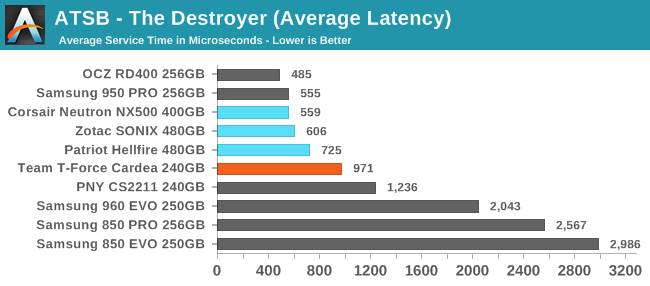
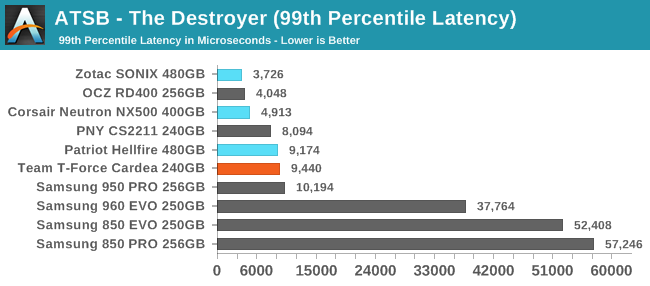
For both average and 99th percentile latency during The Destroyer, the T-Force Cardea is the slowest Phison E7 SSD. The Phison drives all have decent 99th percentile latency, while most of Samsung's drives have more significant outliers.
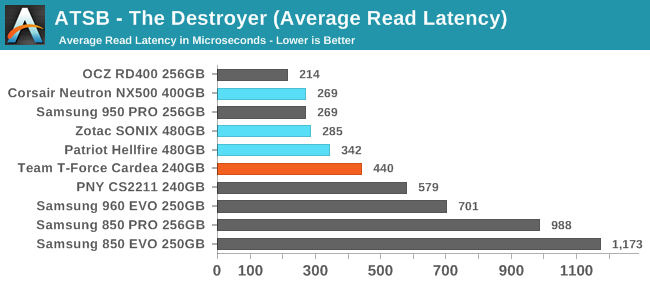

The rankings for average read and write latencies are mostly the same, with the T-Force Cardea coming in last among the Phison E7 drives but still scoring much better than the Samsung 960 EVO.
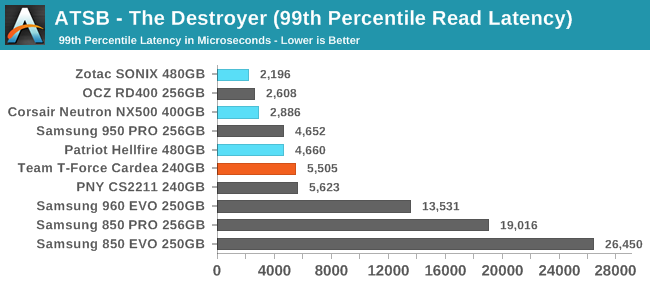
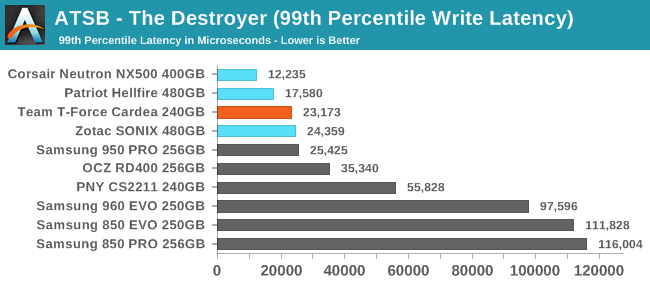
The Phison E7 drives do fairly well at keeping latency outliers under control, though there are major differences between firmware versions. The T-Force Cardea's 99th percentile read latency is much better than the Samsung 960 EVO but also clearly slower than the other Phison E7 drives. On the write side, the T-Force Cardea's 99th percentile write latency is not the slowest among the Phison E7 drives, and all the Phison E7 drives score better than the competition.
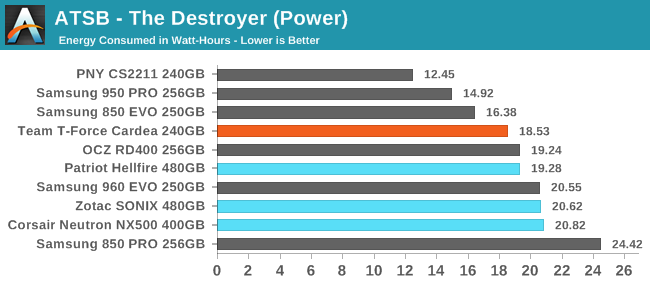
The Team T-Force Cardea has good power efficiency on The Destroyer, with lower total energy usage than any other NVMe SSD in this bunch except the discontinued Samsung 950 PRO.










22 Comments
View All Comments
MajGenRelativity - Thursday, September 28, 2017 - link
While this drive doesn't seem too interesting, I'm very interested in your upcoming review on M.2 Thermal Throttling!Pinn - Thursday, September 28, 2017 - link
You should see it by using ~10G files and a ram drive. The Intel card SSD is much more consistent than the M.2 sticks I've tried.Dr. Swag - Thursday, September 28, 2017 - link
Did you guys change some things? Because it feels like some of the results are different, as I remember the 960 evo doing a lot better before...evilspoons - Thursday, September 28, 2017 - link
These results only include the 250 GB 960 Evo, which is the bottom of the line for the 960 series. IIRC the controller is kneecapped due to having a minimum number of NAND chips available and has no parallel processing ability... hence why reviews like this are interesting!Billy Tallis - Thursday, September 28, 2017 - link
Yep. Our initial review of the 960 EVO only included results from the 1TB model, because our first 250GB sample died during testing. The replacement has been working fine, but its performance profile is very different from the 1TB.The relationship between performance and capacity was the biggest reason I wanted to review this drive; it was the first 240GB Phison E7 sample offered to us.
mapesdhs - Thursday, September 28, 2017 - link
It's shocking how much better than 950 Pro is over the 960 EVO a lot of the time. Other reviews show the EVO has issues with steady state performance even at higher capacities. It's why I bagged a lightly used 950 Pro 512GB recently; noticed someone else no doubt delighted at getting another for 130 UKP BIN. :D And of course, the 950 Pro has its own boot ROM (why the heck did Samsung ditch that? Such a useful feature for older chipsets).CheapSushi - Sunday, October 1, 2017 - link
There's an inherent performance and latency difference between MLC (Pro) and TLC (EVO) NAND. Even with updates, better controllers, etc, it is always there (2 bits per cell vs 3 bits per cell).Dr. Swag - Thursday, September 28, 2017 - link
Ah I see. Interesting to see such a large performance gap, though I guess it makes sense.Gasaraki88 - Thursday, September 28, 2017 - link
I wonder why you guys never reviewed the MyDigitalSSD BPX. It's one of the fastest Phison E7 controller SSDs and the cheapest.DanNeely - Thursday, September 28, 2017 - link
MyDigitalSSD would have to send one in for review...